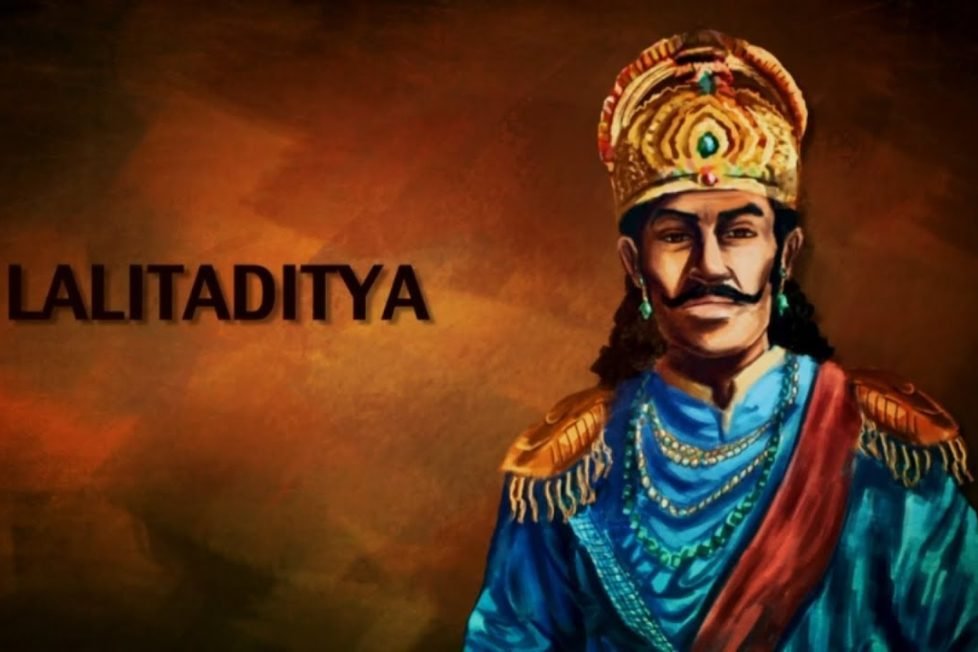Lalitaditya Muktapida- Origin, Heroism and Legacy


While we read about Indian history, the majority of explanations consist of how Britishers and Mughals ruled us. An expression is tried to set that India has always been ruled by invaders and there’s no story of valor of Indian kings. But the war of narrative continues and many researchers and scholars have come up with the conclusion that Bharat was actually a robust civilization ruled by many valorous kings such as Cholas, Gurjara-Pratiharas, Satvahanas, etc.
One such valiant king who stood against foreign invaders was a brave and popular Kashmiri King. Lalitaditya Muktapida was his name, and he belonged to Kashmir’s Karkota dynasty.
Throughout his reign, this Hindu king never saw defeat and grew his dominion in every way. This monarch of Kashmir is one of the few figures in Indian history to have avoided defeat. Durlabha-Vardhana was the founder of this Karkota dynasty. According to many distinguished historians, this king was wed to the daughter of Baladitya, the final ruler of the Gonanda dynasty.
The Chinese traveler claimed that Takshasila (Rawalpindi District), Simhapura (Salt Range), Urasa (Abbottabad District), Punch, and Rajouri made up Hiuen Tsang Kashmir during the rule of Durlabha-Vardhana. i.e., the king was in charge of northwest Punjab.
Lalitaditya, the fifth king of the Karkota Dynasty, came to power in 724 AD. He wanted to annex the surrounding kingdoms and adhere to an expansionist policy.
It is thought that he joined forces with Yasovarman to vanquish the Tibetans. Additionally, his diplomatic missions against the formidable Tibetans were welcomed by the Chinese rulers. This action was well received by the Chinese emperor, who saw the king of Kashmir as a trustworthy ally. The harsh reality is that Chinese military assistance never materialized.
However, Lalitaditya was still able to keep his realm and its inhabitants safe from attackers. Along with these tribes, he also vanquished the Kambojas, Turks, and Dards.
Additionally, he vanquished Yasovarman, the strong king of Kannauj, to become known as the champion of northern India.
The monarch of Kashmir attempted a Digvijaya, according to Kalhana (World Wide Campaign). The author claims that the king made it to east India’s seashore (Kalinga).
The king of Gaur (Bengal), who is thought to have been the first to acknowledge the suzerainty in this instance, showed respect for the king of Kashmir by sending him many elephants. Later, Lalitaditya allegedly crossed the Kaveri and conquered a number of islands. From there, he traveled west and took Avanti.
However, many historians contend that the Lalitaditya southern expedition described in Rajatarangini is wildly exaggerated. But even so, it can help us understand this great Hindu King’s legacy and the size of his dominion.
Lalitaditya subdued the Kambhojas, Turks (Tukharas), Tibetans, Dardas, and Arabs during his rule. Lalitaditya is thought to have enlisted some highly skilled military strategists from China as mercenaries in his army. Lalitaditya also began hiring Turks from central Asia when he expanded the realm towards the northwest.
The Indian subcontinent’s northwest boundary was under threat from the Arabs throughout his rule. Furious warlords who had already unified the Middle East and North Africa were the new conquerors.
But the Hindu Monarch of Kashmir valiantly blocked the Arabs’ advance. During his rule, it’s thought that king Lalitaditya routed the Arabs four times. Some areas of Punjab are thought to have been taken from the Arabs by Lalitaditya.
This kind of leadership was responsible for the conquering of locations like Turfan and Kuchan in the modern Chinese region of Xinjiang. He also ruled over Afghanistan in modern times, which is located in the silk route region.
Lalitaditya amassed enormous wealth and resources through his never-ending conquests. He wisely made use of them, embellishing his domain with towns, monasteries, temples, and god representations. In his newly created capital, Parihaspura, the Hindu ruler also erected numerous temples. According to Kalhana’s Rajatarangini, Lalitaditya produced the five important works Parihasakesava, Muktakesava, Mahaviraha, Govardhanadharana, and Rajavihara.
The Great Martand Temple of Kashmir is one renowned masterpiece of Lalitaditya’s rule. Now, though, it is a ruin.
Around 760 CE, Lalitaditya passed away. He supported art and culture while defending the empire from several invasions over the course of his 36-year rule. Historiographers gave him the moniker “Alexandar of Kashmir” in recognition of his conquests and support of the arts, culture, and learning.
Later rulers of this dynasty lacked Lalitaditya’s strength and resolve. Till the middle of the ninth century, the Karkotas of Kashmir stayed in that region.
DISCLAIMER: The author is solely responsible for the views expressed in this article. The author carries the responsibility for citing and/or licensing of images utilized within the text.
